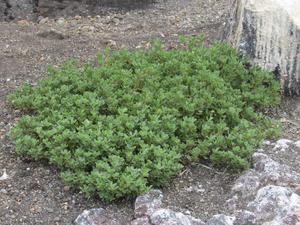Scientists trace origins of now extinct plant population from volcanically active Nishinoshima

image:
Populations of Portulaca oleracea on Nishinoshima, an active volcanic island.
view moreCredit: Tokyo Metropolitan University
Tokyo, Japan – Scientists from Tokyo Metropolitan University have determined the genetic lineage of a now extinct plant population from Nishinoshima, a volcanic island whose frequent eruptions periodically “reset” the vegetation. While they traced the lineage to a nearby island, they discovered distinct genetic quirks due to the rarity of seeds making it there, including a “founder’s effect”. Their findings offer a rare glimpse into the very earliest stages of ecosystem development in an isolated environment.
Nishinoshima, a part of the Ogasawara Island chain, lies approximately 1000 kilometers south of mainland Tokyo. It is home to regular volcanic activity; a recent series of major eruptions in 2013 destroyed nearly all its vegetation. As devastating as this is for plant life, these periodic “resets” and the sheer remoteness of the island afford scientists a rare glimpse into the early development of ecosystems, as newly arrived genetic material struggles to create a foothold.
A team led by Professor Koji Takayama of Tokyo Metropolitan University, formerly affiliated with Kyoto University, has been investigating samples of common purslane, Portulaca oleracea, recovered from the island in 2019, just before an eruption destroyed virtually all flora on the island. While the species itself is found across temperate and tropical climates worldwide, the population on Nishinoshima is now considered extinct. Genetic analysis was carried out on these rare samples, one of 254 individual samples taken from a total of 51 separate populations sampled from all over Japan and Guam.
Through careful comparison, the team began to uncover where the population in Nishinoshima came from, and where they lay in the “family tree” (phylogenetic tree) of the species Portulaca oleracea. They looked at both chloroplast DNA and a genome-wide survey of nuclear DNA, assigning families based on genetic similarities. It was found that they were most closely related to populations found in nearby Chichijima, another volcanic island. However, it also became clear that individuals from Nishinoshima had distinct genetic traits. Importantly, they seemed to derive from very few individuals, leading to a strong skew in subsequent genetic divergence. This is known as a founder’s effect.
Seeds of common purslane are flat, oblate, and less than a millimeter in size, making it easy for them to disperse via wind, birds, and ocean currents. The team’s analysis, however, showed that opportunities for the plant to survive on the island must have been very limited; the founder’s effect observed in the genetic makeup of the samples was very strong. They also found evidence for genetic drift, where isolated events such as typhoons and volcanic eruptions, not natural selection, are responsible for changes in genetics.
The team’s work is a first glimpse into the phylogenetics of a now extinct population. The unique environment of the islands gives scientists a glimpse into the nascent stages of genetic evolution in isolated island environments, from how populations are established via the transport of seeds, to how they survive and thrive. This may also lead to insights into how plant populations are reestablished in the aftermath of natural disasters.
This work was supported by KAKENHI (JP23K23945, JP23K20303, JP21KK0131) Grants-in-Aid from the Japan Society for the Promotion of Science (JSPS), the Environment Research and Technology Development Fund (JPMEERF20204006) of the Environmental Restoration and Conservation Agency of Japan, Environmental Surveys by the Ministry of the Environment, and the Eco-LOGIC-al Network Project of The Tokyo Metropolitan Government.
Journal
Plant Systematics and Evolution
Article Title
Origin of populations of Portulaca oleracea on Nishinoshima, an active volcanic oceanic island
Article Publication Date
28-Jul-2025